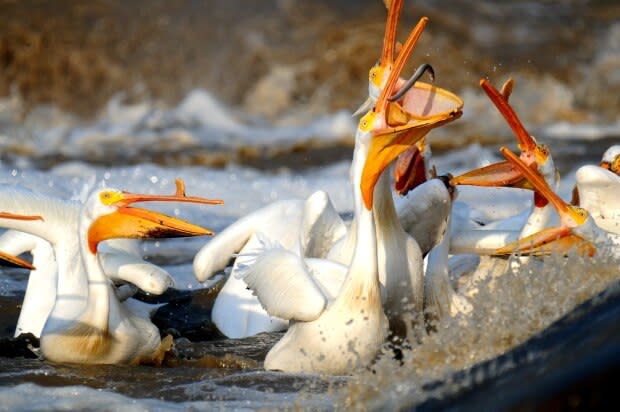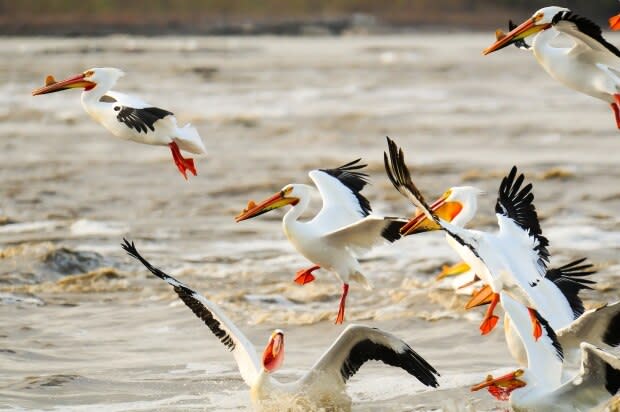'They get around': Pelicans spotted as far north as Kugluktuk, Nunavut
Pelicans have landed near Kugluktuk, Nunavut, near the coast of the Arctic Ocean, and Lashawna Taipana has the photos to prove it.
Taipana said the arrival of pelicans in the northern hamlet of about 1,500 people almost two weeks ago caused quite a stir. It was a first for her or anyone else in the community, as far as she knew.
Initially she and others thought the birds — first seen by some youth during a cleanup at the local landfill — might be swans or possibly even flamingoes. But when they got closer to the birds for a look they realized they were neither.
"There was lots of wonder," Taipana said. "It is a first for us around here."
Kugluktuk wasn't the only northern community that had the unexpected visitors. They've also been seen recently in the N.W.T. near Dettah, and near Wrigley, where Lloyd Moses said he spotted a flock of what must have been between 30 and 40 pelicans soaring in the air.
"You wonder where they're going to go eat!" Moses said.
The birds may have travelled far to arrive in Kugluktuk and Wrigley, but Moses probably need not worry about how they'll feed.

"The fact that the birds are ranging further north probably means that there's fish up there for them to eat," said John McKinnon, lead survey photographer and analyst with the N.W.T.'s Pelican Advisory Circle.
"I'm not sure what brought them all the way up there, but the one thing I do know about pelicans is — where there's fish, there's pelicans, and where there's pelicans, there's fish. So there must be fish up there."
Fort Smith colony has grown
McKinnon, who lives in Fort Smith, N.W.T., near the Alberta and N.W.T. border, is a resident expert on the colony of American White Pelicans near the community. He was out with the colony just before he took a call from the CBC's Norbert Poitras who was hosting Trail's End.
McKinnon can't say for sure why the birds would have made their way to Kugluktuk, which is almost 900 kilometres north of Fort Smith, but the jet stream — which they travel on when migrating — might have something to do with it.
"They get around, these birds," McKinnon said.
"Maybe one or two caught a good gust of wind and took an extra trip and went a little further than the rest of their friends."
McKinnon is pleased to hear of pelicans spotted in other parts of the N.W.T. It's a sign of robust pelican colonies, and in particular, of the health of the colony near Fort Smith. He said the pelican population there has grown from just 27 nests in 1974 (when they first began surveying the bird population), to about 700 over the past few years.

A nest includes two breeding pairs, so that's between 1,400 and 1,500 birds at the colony, not including 500 or so juveniles, or "pre-breeders."
The juvenile birds hang out in their own flock.
"Those birds are known to kind of roam far and wide," McKinnon said. "Potentially those birds in Wrigley may have been those pre-breeders."
Pelicans will often change where they nest if they get disturbed, especially by humans or other predators. - John McKinnon, Pelican Advisory Circle
McKinnon said the Fort Smith colony remains the most northern in North America, as far as he knows, but he said the birds do move around. He's heard reports of nesting pelicans near Big Island on the mouth of the Mackenzie River, as well as north of Fort Smith near the Taltson and Rocher Rivers.
He said at one time, back around 1907, there was another colony in the N.W.T., "somewhere on Great Slave Lake," but it's no longer around.

"Pelicans will often change where they nest if they get disturbed, especially by humans or other predators."
Anyone should count themselves lucky to see the birds in the wild.
"They're very majestic when they're in the air," McKinnon said. "They soar with the greatest of ease and it's quite majestic to watch. When they're feeding in the river and the whitewater rapids and battling down and trying to swallow a ten-pound pike … it's just amazing to watch these big birds in action."
McKinnon said an added perk to watching pelicans at the Fort Smith colony is that they let observers get relatively close — even as close as just 10 feet away, separated as the birds are from spectators by rushing rapids.
But bird watchers should take care not to interfere with the pelicans, no matter where they find them.
"I think we will be seeing range expansion and it would be great to know where the birds are establishing new nesting sites and to make sure that people respect that they've chosen that spot to live and to not disturb them, and to let them be."



